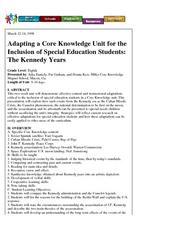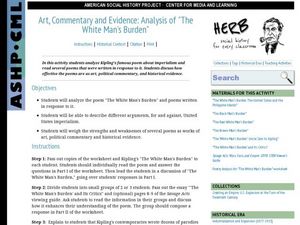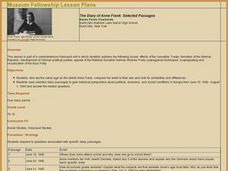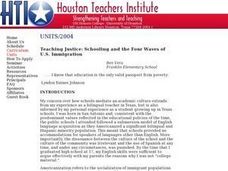Curated OER
The History of the Holocaust From A Personal Perspective
Students research and identify how Holocaust events affected lives of real people who lived in Europe from 1933 through 1945 and after, and create original artwork, poetry, and essays that reflect understanding of Holocaust, and its...
Curated OER
Under the Blood-Red Sun
Fifth graders explore U.S. history by reading an award winning book about World War II. In this Japanese internment camp lesson, 5th graders read the book Under the Blood-Red Sun and discuss the entrapment of Japanese-Americans on our...
Curated OER
The Ethics of the Bomb: What Would You Do?
Learners research the use of the atomic bomb in WWII, analyze the human costs of dropping the bomb and identify the pros and cons. They develop a PowerPoint presentation on the effects of an atomic bomb dropped on their hometown.
Curated OER
The Kennedy Years
Eighth graders read text and view films about the Kennedy administration. In this preseidential administration lesson, 8th graders interview someone who lived during Sputnik, write summaries of lectures, and create posters demonstrating...
Curated OER
Art, Commentary and Evidence: Analysis of "The White Man's Burden"
A cross-curricular activity combines poetry and history for your middle and high schoolers. The class critically examines Kipling's poem, "White Man's Burden" as historical evidence of the Imperialist ideology popular during his time....
Curated OER
Propaganda, WWII, Ghetto‘s, and Analysis of Primary Resources
Young scholars consider the implications of anti-Semitism. In this World War II lesson, students examine selected documents and images featuring the propaganda that promoted Jewish persecution. Young scholars write essays that highlight...
Curated OER
The Diary of Anne Frank: Selected Passages
Students read the novel, "The Diary of Anne Frank". Using the internet, they gather information on the effect of the Versailles Treaty, formation of the Weimer Republic and the Nazi Party on the Holocaust. They view propaganda...
Curated OER
Second World War - Conscription Events
Students explore the iam Lyon Mackenzie King Diaries which describe the involvement of Canada in WWII.
Curated OER
World War II
Students analyze primary sources (photographs) for evidence of American military technology during WWII. They debate the use of the Atomic Bomb. Students view the Rosenthal image. They discuss the image in detail.
National Park Service
The Battle of Stones River: A Contrast in Leadership Styles
US Commanding General William S. Rosecrans led the Union soldiers and Confederate Commanding General Braxton Bragg led the rebel army at the Battle of Stones River. Young historians compare how the leadership styles of these two...
Cengage Learning
Pandemics: Past and Present
From outbreak to epidemic to pandemic. Calls for flattening the curve, social distancing, and face masks. A 12-slide presentation details pandemics and strategies for containment and mitigation of infectious diseases.
Carolina K-12
The Twenty-Sixth Amendment and the Power of Youth
Empower teenagers to take political matters into their own hands! After completing an engaging warm-up activity, class members discuss both sides of the youth voting issue, learn about the connection between military history and the...
Curated OER
The Crusades
Students discover the reasons the Crusades were fought. In this Crusades lesson, students break into groups and research what happened, who was involved and the outcome. Students create a poster with the information and present it to the...
Curated OER
Holocaust Theme
Students complete a unit of lessons on the events of the Holocaust during WWII. They write daily journal entries, create a collage, view and discuss videos, read and analyze novels and poetry, and complete a novel project.
Curated OER
Into the Fifties: Understanding the Context of Film Genres in the Fifties
Learners discuss prior knowledge of American culture during the 1950's. They complete KWL charts, participate in class discussions and view the documentary film Atomic Café. They record their observations from the film.
Curated OER
D-day Message from General Eisenhower to General Marshall
Students analyze a "top secret" document written by Eisenhower. They identify and chart cliches for those about to go into battle and read related poetry. They invite a veteran to describe the D-Day invasion.
Curated OER
Non-Violence Means "Doing Nothing"
Students reflect on violence and non-violence. In this World History lesson, students read an article by Gandhi then write an essay as to whether they agree or disagree with his thoughts. Students then share all their ideas...
Curated OER
Linear Equations
Seventh graders explore battle plans using grids. In this linear equation lesson, 7th graders see how math is used in battle. Students create a grid on the floor using tape and plastic army men to serve as the points. Students...
Curated OER
From One Child to Another: Letters about the Holocaust
Students read biographies of students who survived the Holocaust and write letters describing the effects of those stories. They select one biography and write a letter to that child, telling how the biography affected him or her.
Curated OER
CHURCHILL’S WARTIME SPEECHES: 1940-1941
Students analyze Churchill's speeches. In this modern history lesson plan, students hear and examine several of Churchill's speeches. Students will attempt to determine their effect on galvanizing wartime consensus in Britain.
Curated OER
Oil Spills
Third graders examine the San Francisco oil spill and the effects it has had. In this investigative lesson plan students view a demonstration on oil clean up and how it works. They see how wildlife is rehabilitated, how the...
Curated OER
Teaching Justice: Schooling and the Four Waves of U.S. Immigration
U.S. immigration is the focus of a unit on social justice. Over the course of a school year, young historians read a variety of texts to learn about four waves of immigration that have occurred over time in the U.S. An emphasis on...
College Board
Calculus at the Battle of Trafalgar
All's fair in math and war. Scholars examine the Battle of Trafalgar using calculus. They set up and solve a system of differential equations to determine the number of ships remaining in each fleet over time.
Agriculture in the Classroom
Growing a Nation: Into a New Millennium 1970-Present
If you want to focus on critical thinking skills, this well-constructed series of activities will challenge your history or agriculture class to evaluate the effectiveness of administrative decisions related to agricultural and the...
Other popular searches
- Civil War Effects
- Effects of War on Civilians
- Social Effects of Wars
- Effects of World War Ii
- Global Warming Effects
- Effects of World War I
- Effects of Global Warming
- World War I Effects
- Us Civil War Effects
- Vietnam War Effects
- The Effects of War
- Civil War Cause and Effects























